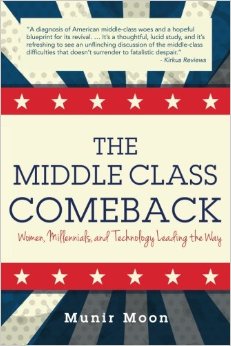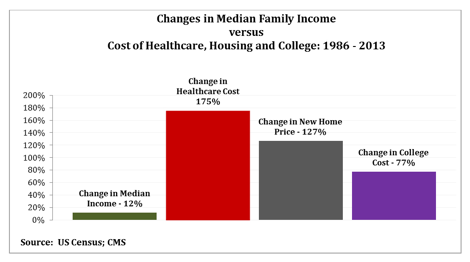By Munir Moon | (Informed Comment) | – –
The middle class is getting crushed. But there is hope. The most common argument about the middle class destruction is the declining or stagnant income, which is true. However, the main culprits are the costs of healthcare, education, and housing that have increased at a much higher rate, making it impossible for an average American family to attain a middle-class lifestyle (see chart below). Furthermore, the tax policies have exacerbated the problem by creating after-tax income and wealth inequality, favoring the non-working income taxed at a lower rate than the working income. Despite the doom and gloom about the middle class making headlines, there are three major forces working together—women, millennials, and technology, which provide hope for the future.
One of the reasons for that optimism is women gaining ground with men in almost every segment of society, such as higher education, healthcare, business, and even politics. For the first time in United States history, a woman, Hillary Clinton, has been nominated for president by a major political party—getting closer to breaking the ultimate glass ceiling. Almost 50 percent of the law and medical degree earners were women in 2010 compared to only 10 percent in 1971. Women have surpassed men by two-to-one in earning four-year college degrees from 1980 to 2013, according to a report by the Institute of Education Sciences, part of the Department of Education.
Furthermore, women control $11 trillion, or almost 40 percent, of the nation’s investable assets. Even though they make up half of the population, they are still well under-represented in society when it comes to making decisions in private and public deliberations on the economy, education, healthcare, politics, and social issues. Therein lies the opportunity for women to grow their influence since it cannot get worse than what it is now. As women gain more parity with men, such as in the job market, they will contribute more money to the family income and will lead the way toward the middle-class comeback.
Millennial women are the first ones in modern history to start their working lives with near parity with men in terms of earnings, according a survey by Pew Research. In 2012, among workers ages twenty-five to thirty-four, women’s hourly earnings were 93 percent of men’s hourly earnings.
Millennials, who represent 25 percent of the adult population, will be the largest voting bloc over the next few decades. About half describe themselves as politically independent. They are social liberals and fiscal centrists, according to a survey by the Reason Foundation. Their voices will shape the future of the country, particularly for the middle class. Millennials are transforming existing industries while creating new ones, whether it is in communication, media, or goods and services. They are creating jobs, enhancing purchasing power, and improving the quality of life for all, including the middle class.
Technology will force the existing private and public institutional structures to be efficient amid the digital age. Over the last thirty years, technology has made astounding changes. Smartphones and other technological products that are very complex yet very simple to use will continue to add productivity to the economy.
Sky rocketing costs of key factors adversely impacting the middle class, as mentioned above, offer a fertile ground for disrupters. These disrupters are in the process of transforming the healthcare and higher education delivery models. The net result of all these transformations will be lower costs of healthcare, education, and housing, which in turn will increase the purchasing power of the lower and middle class.
On the political front, Donald Trump and Bernie Sanders have already challenged and shattered the age old political process utilized by Democrats and Republicans. Political disrupters will take the power away from The Beltway Beast as an anti-establishment mood prevails. They will lead to the transformation of the political process of electing our leaders. That in turn will lead to the transformation of the tax structure, which would be fair and affordable, making way for the middle-class comeback.
Munir Moon is the president of Bertech, a Southern California-based small business that has been recognized three times as one of the top 500 fastest-growing small businesses by Inc. 500. He is a contributor at The Huffington Post and LAprogressive.com. He earned his B.S. in engineering, M.S. in economics and M.B.A. in finance from UCLA. He is married with three sons and lives in Los Angeles County, California. He is author most recently of The Middle Class Comeback: Women, Millennials, and Technology Leading the Way


 The Middle Class Comeback
The Middle Class Comeback 

 © 2025 All Rights Reserved
© 2025 All Rights Reserved